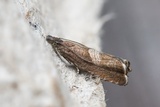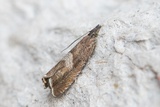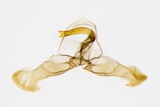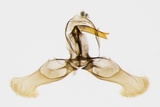Dichrorampha acuminatana (Lienig & Zeller, 1846) Species
Last modified: Nov. 25, 2025, 12:33 p.m.
A not so common species throughout Belgium.
Details
- Classification
- Family: Tortricidae > Subfamily: Olethreutinae > Tribus: Grapholitini > Genus: Dichrorampha > Species: Dichrorampha acuminatana
- Vernacular names
- Margrietwortelmot (NL), Sharp-winged Drill, Common Daisy Moth (EN), Gewöhnlicher Margeritenwickler (DE)
- First mention in Belgium
- De Crombrugghe G. 1899. Note sur quelques Microlépidoptères nouveaux pour la faune belge. — Annales de la Société Entomologique de Belgique 43: 72–76. On page 73.
- Status
-
Native
Distribution
Imago
Wingspan 10–15 mm. This is a dark purplish brown species with a clear white band in the cilia, a dorsal patch with striae, small black dots on the termen and plumbeous striae from the pale costal strigulae. .
Most of the species in this genus should be checked for genitalia, especially when worn.
Caterpillar
Whitish body with a brown head brown, laterally darker and prothoracic plate brownish.
Bionomics
The larva lives in the rootstock, tunnelling down into the roots of the food plant. It hibernates in the larval stage. Pupation in a silken cocoon in the larval habitation.
The adults are readily disturbed from rest during the day. They are active towards late afternoon and later come sparsely to light.
Flight periods
The adults fly in two generations a year from end of April till late June and again from early July towards late September. Most observations during May and August.
Observed on
- Host plant (species):
- Leucanthemum vulgare
The larva lives on Leucanthemum vulgare. In literature is Tanacetum vulgare also mentioned, but this is still uncertain.
Habitat
It inhabits flowery grasslands and roadsides.





